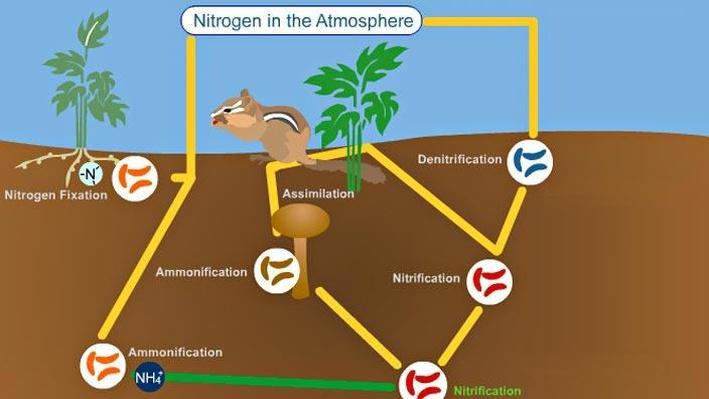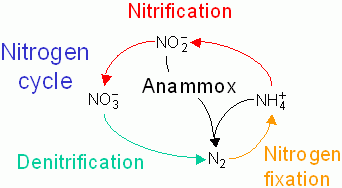We are generally under the impression that we only need oxygen to live. Well, you couldn’t be more wrong! There is a laundry list of elements that animals need for survival. One such element is Nitrogen. But we can’t just get nitrogen from the air. It needs to be converted to nitrates, via a process called nitrogen cycle. So let us learn more about this fascinating concept.

The air we breathe contains 78% nitrogen, 21% oxygen and remaining are other trace gases. The nitrogen component of air is inert. So this means plants and animals cannot use it directly. To be able to use nitrogen, plants convert atmospheric nitrogen to nitrates, nitrites and ammonia compounds by a process called the nitrogen cycle. Animals derive their nitrogen requirements from plants.
Suggested Videos
What are the steps involved in the nitrogen cycle?
Nitrogen cycle consists of four main steps namely:
- Nitrogen Fixation
- Ammonification/ Decay
- Nitrification
- De-nitrification
It is important to note that microorganisms play an important role in each of these steps.
Browse more Topics under Microorganisms
- Disease-causing microorganisms
- Food Preservation
- Microorganisms and its uses
- Heterotrophs
- Inoculation
You can download the Nitrogen Cycle Cheat Sheet PDF by clicking on the Download button below

What is the mechanism of each of these steps?
Nitrogen Fixation
This is the first step of the nitrogen cycle. This step is characterized by the conversion of atmospheric N2 into ammonia (NH3). Bacteria like Azotobacter and Rhizobium have a major role in this process. They are harbored in the roots of the leguminous plants and help convert inert nitrogen to ammonia. Nitrogen fixation can occur in any of the following ways: atmospheric fixation (involves lightening), industrial fixation(manufacturing ammonia under high temperature and pressure condition)

Assimilation
Once the nitrogen has been fixed in the soil, plants can absorb nitrogen through their roots. This process of absorption is known as assimilation.
Ammonification
This is another process by which ammonia can be generated. Organic remains of plants and animals are broken down in the soil by some bacteria to release ammonia into the soil. These dead and waste matter is used by these microorganisms as food and they release ammonia into the soil.
Nitrification
This occurs in two-steps. The first step is in which NH3/NH$+ is converted to NO3- (nitrates). The bacteria Nitrosomonas and Nitrococcus present in the soil convert NH3 to NO2-, and another bacterium, Nitrobacter converts NO2- to NO3-. These bacteria gain energy through these conversions.

Denitrification
Is the reverse of nitrification that occurs in the deep layers of soil where the bacteria convert NO3- is converted into N2 and other gaseous compounds like NO2. This occurs because in deep layers of soil, oxygen is not available and the soil bacteria use these nitrogen compounds instead of oxygen.
What are some Essential Mineral Elements?
What is the importance of the nitrogen cycle?
- As we all know by now, the nitrogen cycle helps bring in the inert nitrogen from the air into the biochemical process in plants and then to animals.
- Plants need nitrogen to synthesize chlorophyll and so the nitrogen cycle is absolutely essential for them.
- During the process of ammonification, the bacteria help degrade decomposing animal and plant matter. This helps in naturally cleaning up the environment.
- Due to the nitrogen cycle, nitrates and nitrites are released into the soil which helps in enriching the soil with nutrients needed for cultivation.
- As plants use nitrogen for their biochemical processes, animals obtain the nitrogen and nitrogen compounds from plants. Nitrogen is needed as is an integral part of the cell composition. It is due to the nitrogen cycle that animals are also able to utilize the nitrogen present in the air.
Solved Example for You
Q: Nitrates are converted into Nitrogen by
- Ammonifying Bacteria
- Denitrifying bacteria
- Nitrogen-fixing bacteria
- All of the above
Solution: The correct answer is “b”. Denitrification is the process where after nutrients are converted back into ammonia, anaerobic bacteria will convert them back into nitrogen gas.
FAQ’s for You
Q1. Explain nitrogen cycle in nature and define all the terms involved in it.
Answer:
Terms involved in nitrogen cycle are
1. Nitrogen fixation : Plants cannot use free nitrogen present in the air. This nitrogen molecule is converted into nitrates and nitrites which can be taken up and used to make the required molceule. This is called nitrogen fixation which can be done by the bacterias that live in the root nodules of leguminors plants. By physical process during lightning, the high temperatures and pressures is created in the air which convert nitrogen into oxides of nitrogen and dissolve in water and come down along with rain. This is also called nitrification.
2. Ammonification. The nitrogen compounds formed are taken by plants to form proteins which are further converted into ammonia.
3. Denitrification. The nitrates and nitrites of nitrogen are acted upon by other group of microbes e.g. Pseudomonas bacteria,which convert these compounds into free nitrogen gas.
Nitrogen cycle:
1. Free nitrogen from atmosphere is converted into nitrates by bacterias or by lightning.
2. Nitrates mix with soil, is absorbed by the plants to make proteins.
3. The proteins in plants and animals are converted into amino acids and ammonia.
4. Ammonia is converted into nitrates nitrates and then these nitrates and nitrites present in soil is acted up on by other group of bacterias called denitrifying bacteria. The process is called denitrification, nitrates are converted into free nitrogen and is released back to the atmosphere.
Q2. In nitrogen cycle, atmospheric nitrogen is fixed by bacteria and converted into ammonia. Ammonia is further converted into other forms of nitrogen. At the end of the cycle it returns to the atmosphere by the process of
A. Ammonification
B. Nitrification
C. Dentrification
D. Assimilation
Answer: The nitrogen cycle is the recycling phase of the nitrogen which includes nitrogen fixation, ammonification, nitrification, and denitrification. Denitrification is the process through which the nitrates and nitrites are converted back to atmospheric nitrogen. This process is performed by the anaerobic bacteria.
Thus, the correct answer is option C.
Q3. In nitrogen cycle which bacteria are responsible for nitrification?
Answer: In nitrogen cycle Nitrosomonas & Nitrobacter bacteria are responsible for nitrification) During nitrification, the nitrogenous wastes from dead plants and animals are converted into ammonia by the action of bacteria such as Bacillus ramosus, Clostridium spp. etc.
The microbes which carry out biological nitrogen fixation are commonly called biological nitrogen fixers. for eg: Rhizobium and Azotobacter.
So, the correct answer is ‘Nitrosomonas & Nitrobacter’.
Q4. Explain the nitrogen cycle?
Answer: A continuous series of natural processes by which nitrogen passes successively from air to soil to organisms and back to air or soil involving principally nitrogen fixation, nitrification, decay, and denitrification.








Leave a Reply